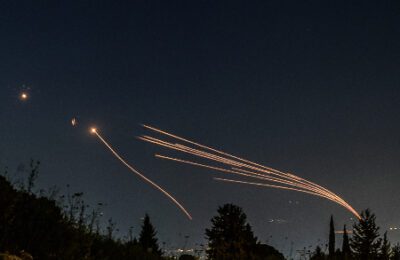I write to you from the eternal city of Jerusalem. The city that raised me. And the city that continues to raise me anew, each and every time my presence and this magical city collide.
Not to mention, Jerusalem-the-city that gave me my “View From Jerusalem,” where, for the first time, I put pen to paper and began writing.
There are still so many places I usually visit here, spend time in and soak up — which I haven’t yet stepped foot in on this trip.
And yet, as cliched as it sounds, it is home. That feeling of the intangible — here, it’s almost tangible.
Home it was and, to an extent, home it shall always be.
No matter where in Israel I reach — for indeed, this trip has already expanded my horizons and brought with it new moments, new places and new experiences — it’s Jerusalem that lives at the heart of the concentric circles of this country.
Serendipity knocked at the door, and already in the car in the ride from the airport to Jerusalem a detour led to an unforgettable encounter.
Ramat Raziel, heretofore unknown to me, a little charming neighborhood nestled in the hills on the outskirts of Jerusalem — maybe all of one or two streets of private garden homes, basically, an exit off the highway — if you blink you could miss it. I must have been blinking through the years.
Under an hour of departing from Ben Gurion Airport, I found myself face to face with a 1973 Yom Kippur War hero. I found myself sitting on a chair mere inches across from an older man, his face framed by a thick snowy white beard, his cane resting against the chaise lounge he was ensconced in. Hassan, his devoted aid, offered a cup of coffee.
Rav Yossi Harel was a soldier when the Yom Kippur War struck. Nothing prepared him for the horrors he would be exposed to, and the tasks he had to bear that would change his life forever. It is one year shy of 50 years since the war, and Rav Harel’s memories are as visceral as though he was emerging from battle today. He began weeping softly, and speaking of his struggles — the visions he has of the grim task of burying the hundreds of young, dead after the Suez Canal battle, an unwanted destiny visited upon him.
It’s the inescapable shadow of his life that haunts him til this very day.
Aside from the wailing, the thunderous gunfire, the deafening explosions — I will spare you the graphic details of the burials he described he sees before his eyes; the inescap-able trauma he lives with daily.
As quickly as the onset of the conversation was its intensity, and so too was the sharp turn in the conversation. “Here is a picture of Rav Shlomo Goren and I on a boat”—I can’t remember which juncture of the battle Rav Harel attributed to the photograph.
Up against the high ceiling above the chaise lounge and across the length of the room stretched a plexiglass display case, showcasing precious and antique Judaica, such as silver Torah scrolls, ancient texts and the like.
Rav Harel pointed to one of the petite Torahs in the case, and spoke of its story and link to the Yom Kippur War. Then, he said, “you know I’m a direct descendant of the famed Rav Levi Yitzchak of Berdichev, and the Torah Scroll attributed to him is in my ownership.
“Hassan, bring it please, show the tiny Torah.”
Whereupon Hassan appeared, cradling the tiniest, most ancient looking Torah scroll one could ever see.
“Here is Rav Levi Yitzchak’s Sefer Torah,” Rav Harel said as he pointed. This relic from the past, long predating the war Rav Harel is scarred from to this day, shifted his mood and visage. He broke into a smile filled with pride and joy.
“Look at this,” Hassan’s voice could be heard behind a massive white square canvas he was lifting, as a gorgeously artistic depiction of Jerusalem’s Old City was revealed.
“It’s from Zamush,” Rav Harel and Hassan both said, also with great pride. “Zamush just popped by today for a visit and he brought this gift with him. You know, he became a painter, and this is his painting of the Old City of Jerusalem.”
I was the outsider. Who was Zamush? I had no idea. It was quickly explained to me. Zamush, as in Yoram Zamush, the person to whom the historic task of raising the Israeli flag over the Kotel, the Western Wall, in the Six Day War of 1967 fell. Destiny shined on him; the glorious task fell to this young soldier, a private, named Yoram Zamush.
While Zamush was not physically present, his visit was missed by a mere 10 minutes or so.
Here before me lay a tormented man, a Yom Kippur War hero, to whom destiny brought such a harrowing and ghastly task. Yet, a mere few years prior, was another soldier, with a very different, contrasting, and glorious destiny.
I have no idea what the history between the two former soldiers is. Were they friends from the same regiment or platoon? This was a brief visit, I had no time or opportunity to ask.
One thing was clear, these two soldiers destinies were somehow intertwined. For all these decades later, the young soldier to whom destiny offered glory, never to this day forgot about the soldier from the war six years later, to whom the most brutalizing and staggering of tasks fell.
Although we had just missed Zamush’s physical presence, like that intangibly tender and empathic feeling of home Jerusalem invites and had just enveloped me in as we were within her outskirts, so did the after effect of Zamush’s departure.
He still remembers, he still comes and visits the other soldier, the other war hero, Rav Harel, whose destiny turned out to be ever harsher.
“Here you must hold this Torah Scroll attributed to Rav Levi Yitzchak,” Rav Harel interrupted my reverie about the gorgeous blue hued painting that had just been personally delivered by Zamush.
Indeed, crammed along into these brief minutes and small room, where the memory and tragedy of the hundreds of Yom Kippur War fallen IDF soldiers were invoked, it all felt so palpable and visceral; the room where the presence of the modern day figure of Zamush of the Six Day War was ephemeral yet so present.
Right there along with them, and with us in the room, it felt like the holy saintly Rav Levi Yitzchak of Berdichev, renowned for his compassion and the the lengths to which he went in judging people favorably, was right there too.
What a commingling of people and history, entwined like threads through time. Rav Levi Yitzchak from over 200 years ago, the miraculous Six Day War of 55 years ago, and the Yom Kippur victory of 49 years ago, all coalescing within one person, Rav Harel.
On the outskirts of Jerusalem.
After (due to COVID) my longest absence from this city I called home.
On my way.
To Jerusalem.
Copyright © 2022 by the Intermountain Jewish News












